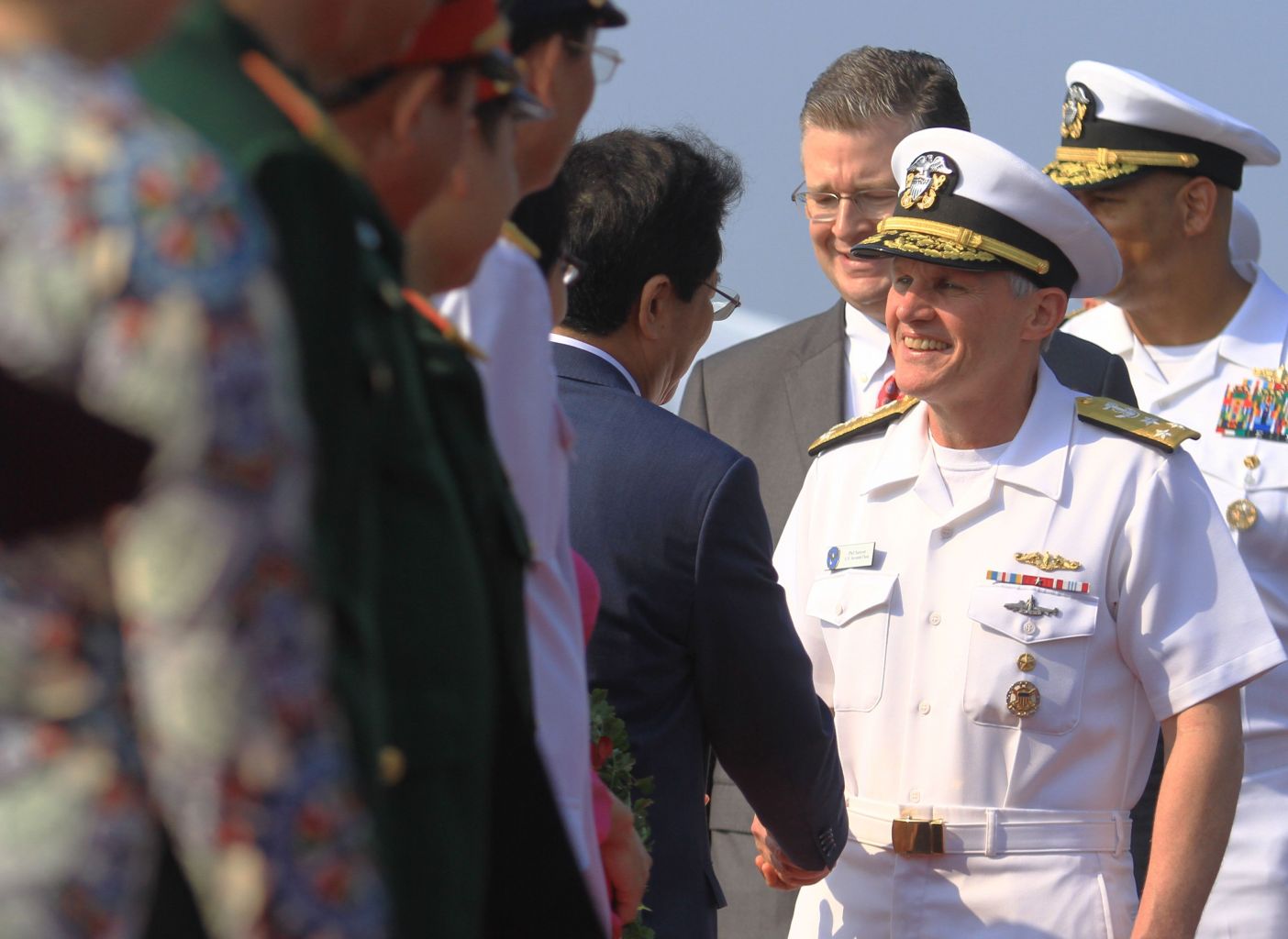Top US naval officer criticises China's lack of transparency on South China Sea
Sign up now: Get insights on Asia's fast-moving developments

Vice Admiral Phillip G. Sawyer (right), commander of the US Navy's Seventh Fleet, greets Vietnamese officials after the US aircraft carrier USS Carl Vinson pulled into port in Danang on March 5, 2018.
PHOTO: AFP
Follow topic:
BANGKOK - China's lack of transparency about its activities in the South China Sea is potentially disruptive to security in the region, a top US naval officer said on Tuesday (March 6) as an American aircraft carrier docked in Vietnam for the first time in over four decades.
Vice Admiral Phillip G. Sawyer, commander of the US Seventh fleet which operates in the region, referred to Chinese land reclamation and militarisation in the waterway, saying the lack of transparency about both was causing "angst" in the region.
"It's not quite clear what's going to happen down there, and I think that angst and that lack of transparency is potentially disruptive to the security and stability of the region. And that causes concern," he told reporters on Tuesday in a telephone briefing.
China has laid claim to most of the South China Sea but the claim has overlapped with those of Vietnam, the Philippines, Malaysia and Brunei. Tensions have simmered since Beijing began reclaiming and fortifying disputed islands while rapidly expanding its naval presence in the region.
China has also been boosting its defence capability. Last year (2017), it unveiled the country's first domestically-built aircraft carrier, a refurbished vessel from the former Soviet Union. On Monday (March 5), China announced an 8.1 per cent budget increase for defence spending this year (2018).
Communist-run Vietnam, which has staunchly defended its territorial claim in the South China Sea, has received aid from Japan and the US to upgrade its coast guard's capabilities.
US officials heralded the visit of the nuclear-powered aircraft carrier, USS Carl Vinson, to Danang as a milestone in ties between the two, once bitter enemies during the Vietnam War.
US Consul General Mary Tarnowka said: "This really reflects our commitment to Vietnam and the US support for a strong independent and prosperous Vietnam, as well as our commitment to a free and open Indo Pacific and a rules-based international order. "
She added: "We want our partners in the Indo Pacific to be proud and self-reliant, not proxies or satellites."
The USS Carl Vinson, which arrived in Danang on Monday, will leave on Friday. It carries 5,300 sailors, pilots, and crew, as well as 72 planes. Its port call in Vietnam followed one to the Philippines last month (Feb).
Activities scheduled as part of the port call to Danang include basketball and football matches, concerts by the navy band and a visit to a centre for victims of Agent Orange, a toxic chemical sprayed by the US to remove foliage during the Vietnam War.
This is not the first time a US aircraft carrier has entered Vietnamese waters. In 2009, the USS John Stennis anchored off the Vietnamese coast and hosted visitors who were flown from the mainland. Similar visits were conducted in 2010 when the USS George Washington was anchored off Danang.
Dr Le Hong Hiep, a fellow at the Iseas-Yusof Ishak Institute, told The Straits Times the fact that a US carrier was docked in Vietnam could be seen as a "symbol of greater trust" and "greater level of comfort" in defence cooperation.
Last September (2017), US and Vietnamese military officers also came together to repair and update infrastructure in central Vietnam, as well as attend seminars on medical and humanitarian assistance.
It remains to be seen if ties would be further upgraded through other initiatives such as arms deals or joint combat-oriented military exercises.
Vietnam has been growing ties with diverse powers, a move many analysts saw as an attempt to counter Chinese dominance in the region. In 2016, Vietnam inaugurated a port at Cam Ranh Bay capable of receiving foreign warships. Since then, it has been used by vessels from US, China, France and Japan.

